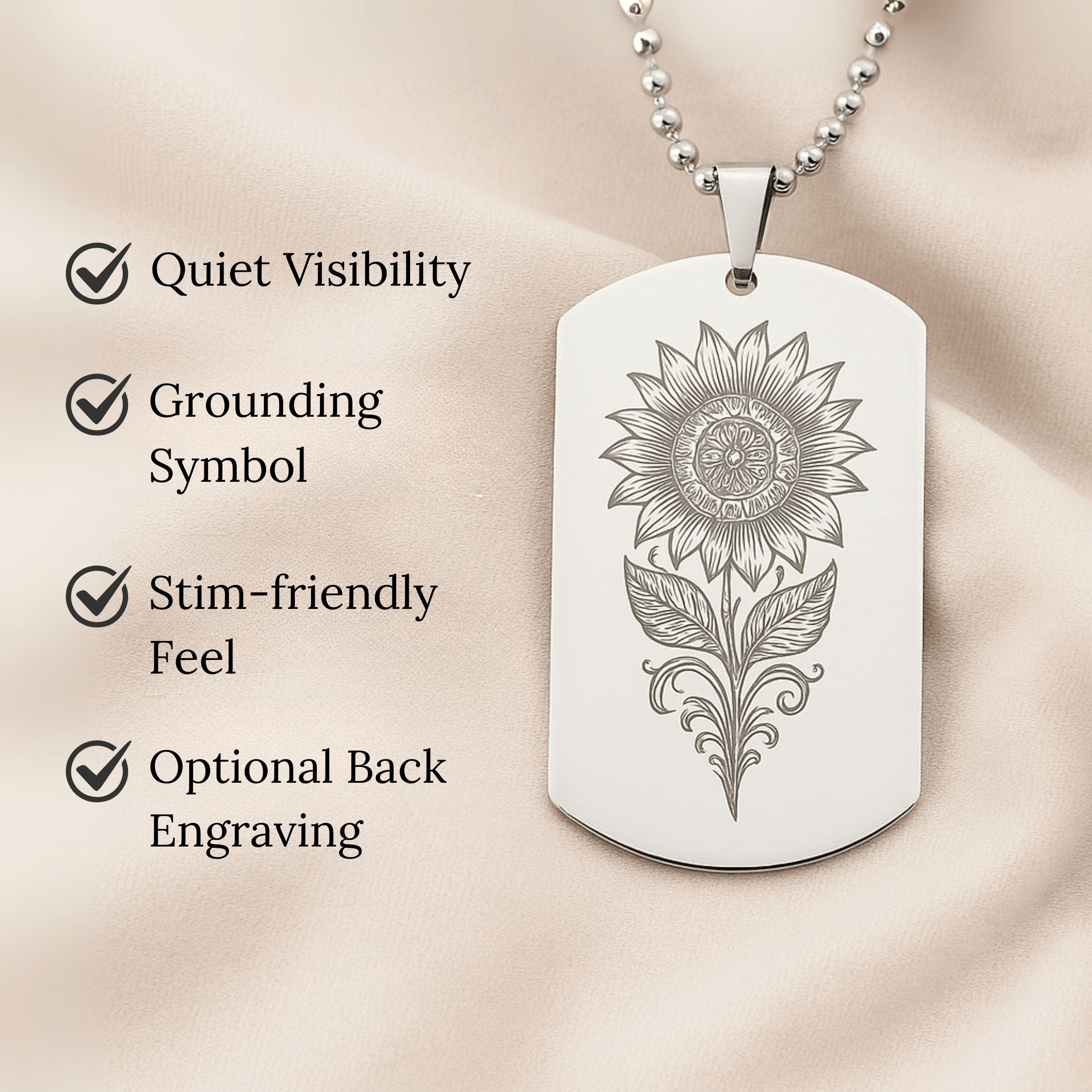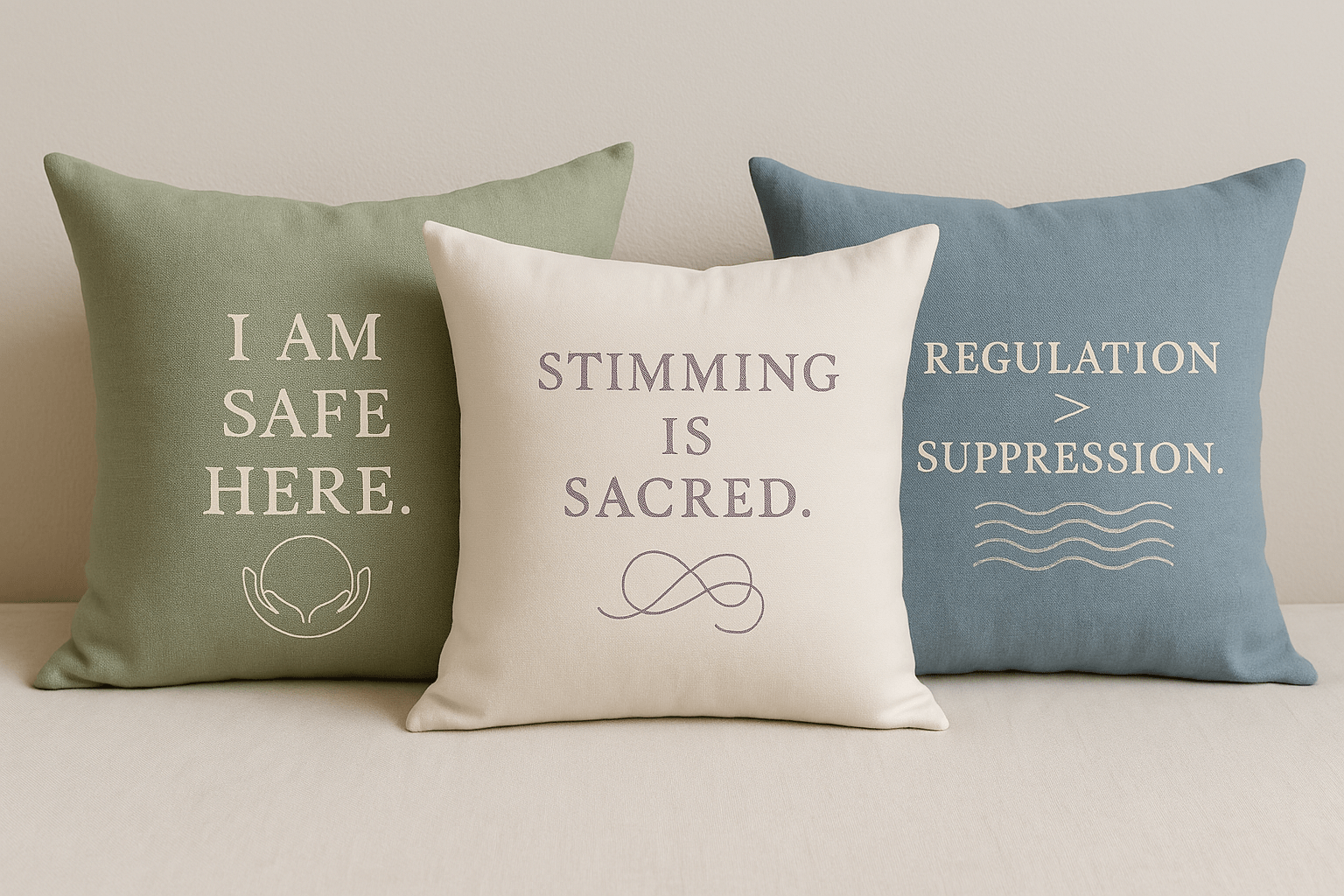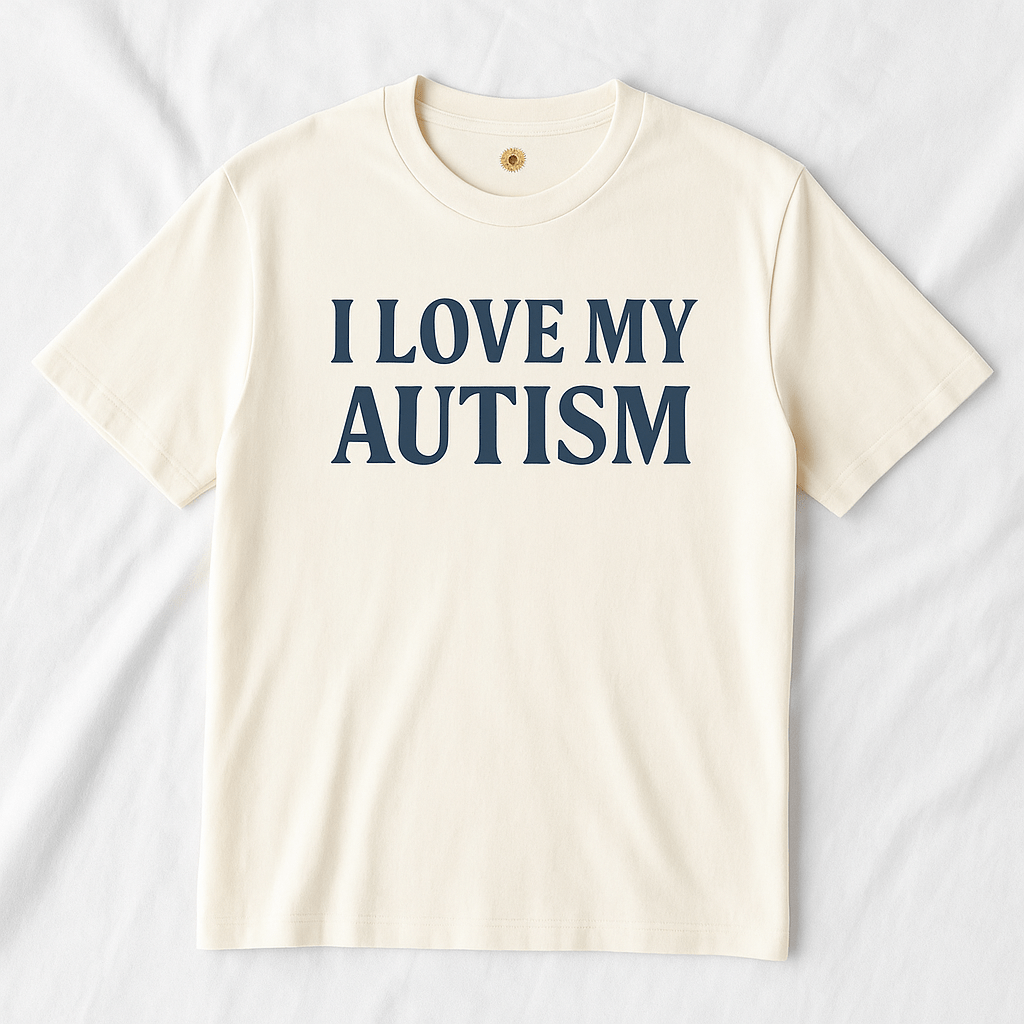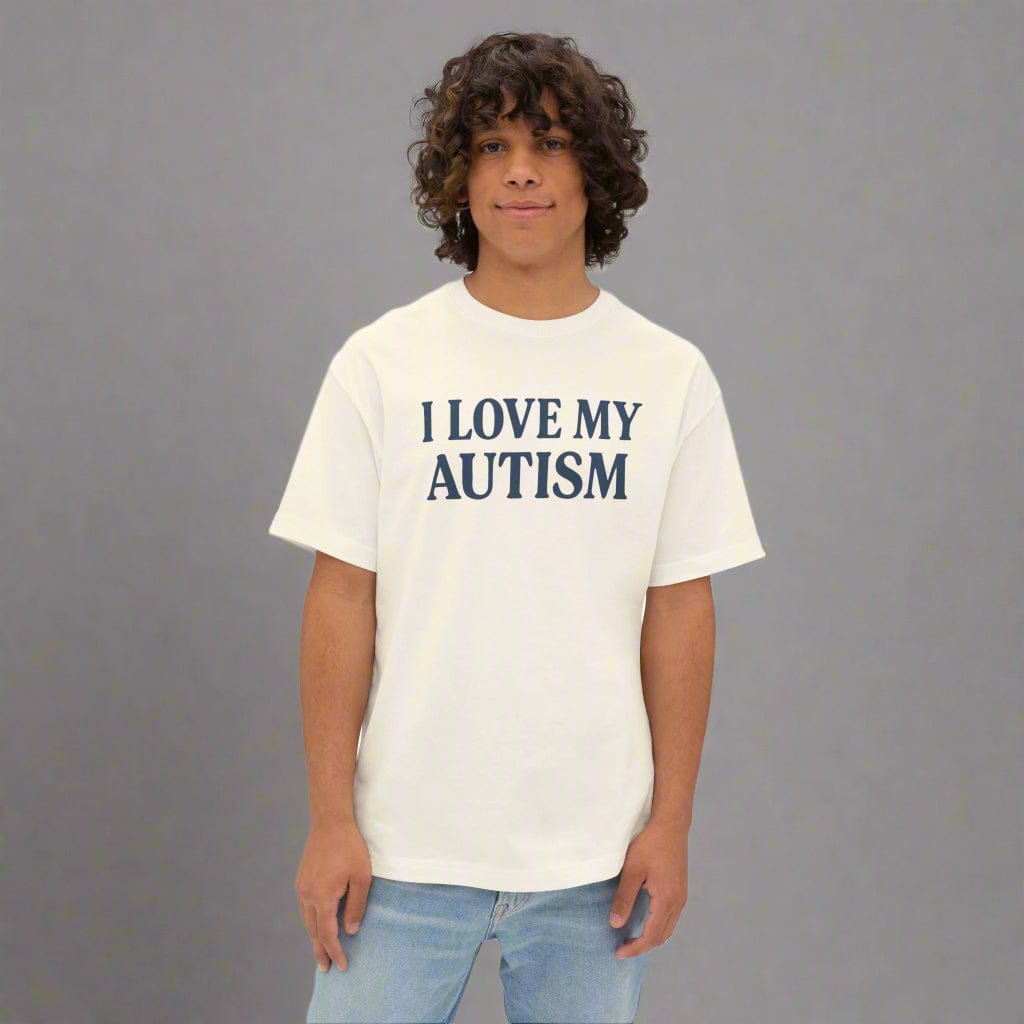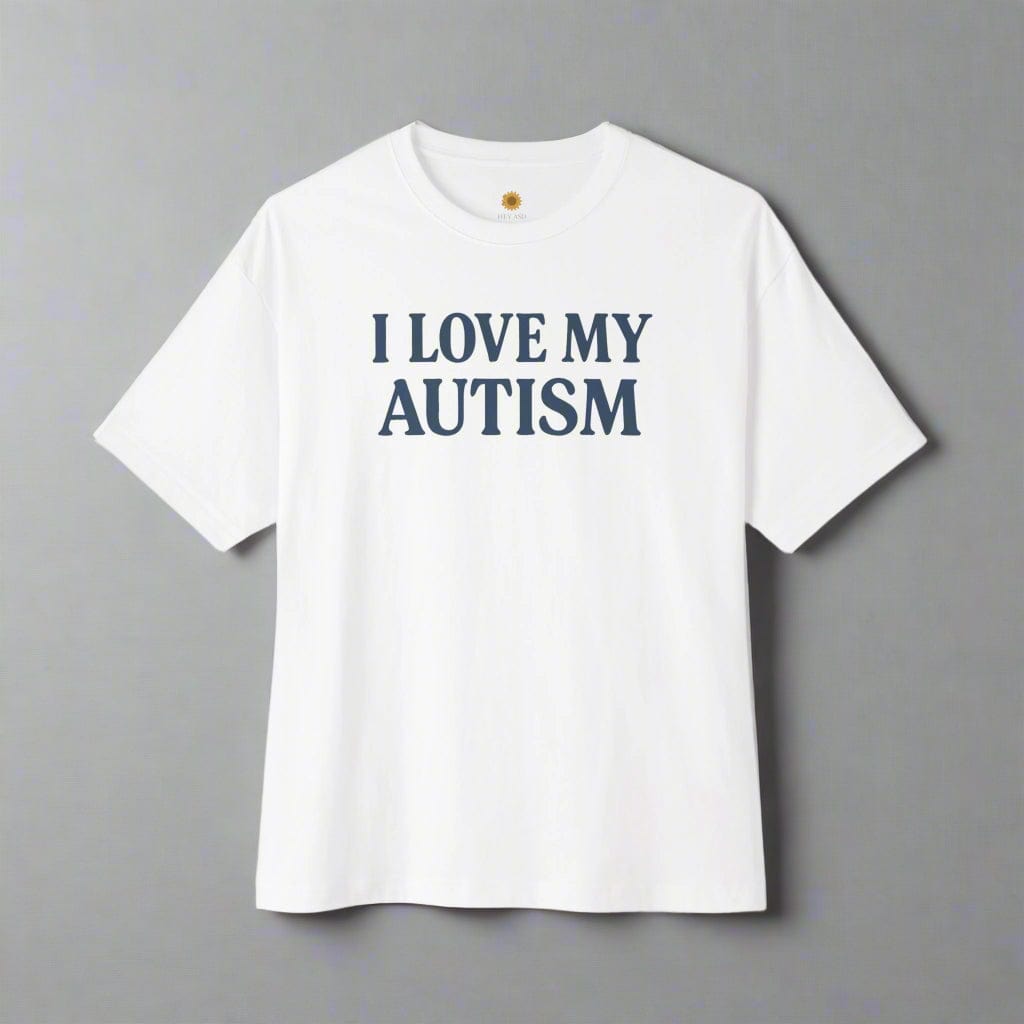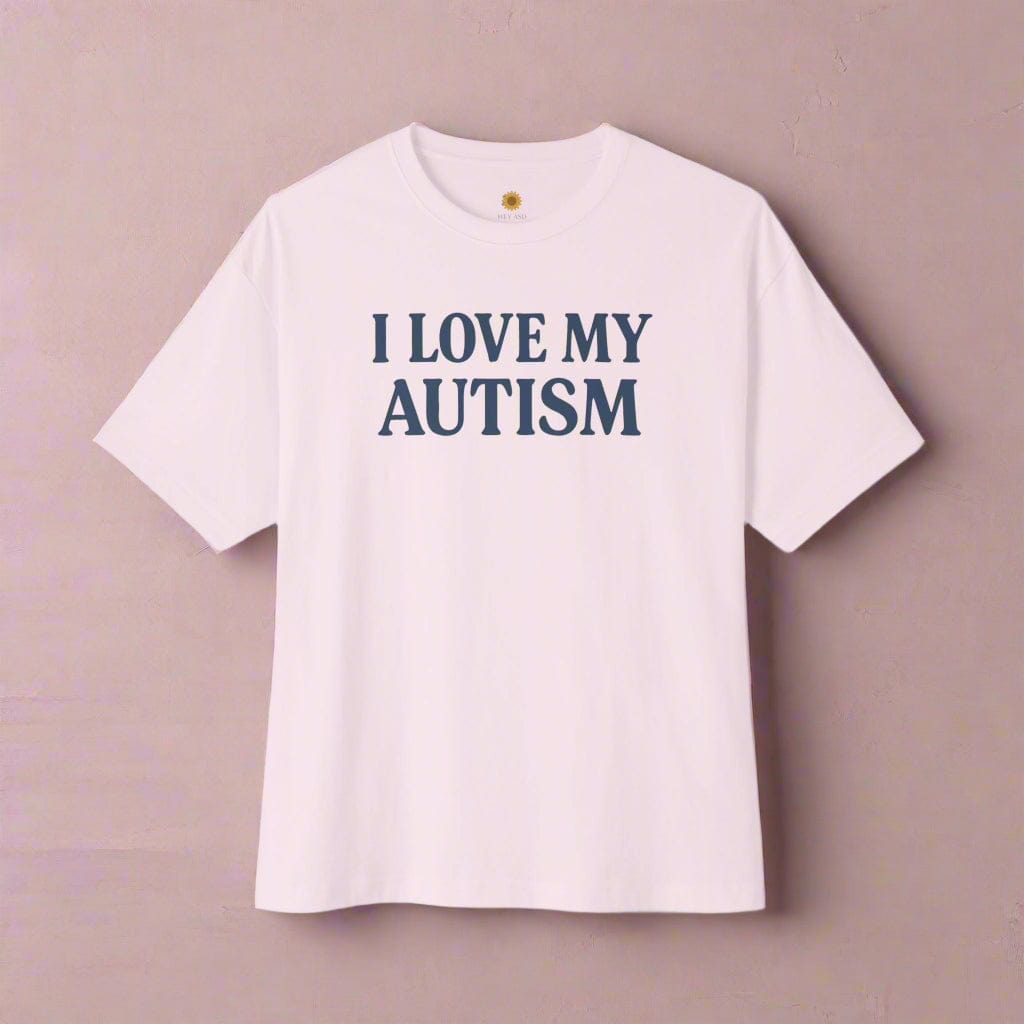When the World Feels Too Loud: Understanding and Calming Sensory Overload

Written by the HeyASD Editorial Team
There’s a moment when the world tilts: sounds stack on top of each other, light feels too sharp, even fabric whispers too loudly against your skin. Your brain is working hard, sorting more than it can hold—and it’s asking for gentleness. That moment has a name: sensory overload.
This guide is written for autistic adults (and anyone who’s ever thought “why does this feel like too much?”). We’ll put words to the experience, map common triggers, and share practical, compassionate ways to regulate—at home, at work, and out in the world. If you’re here because life has felt loud for a long time: you’re not broken. Your nervous system is speaking; we’ll help you listen.
If you’re new to this, you might start with sensory triggers—the specific sights, sounds, textures, and patterns that push your system past its limits. Understanding your pattern is the first step to reclaiming calm.
As an autistic adult, I’ve spent years wondering why normal life felt so loud. The hum of fluorescent lights, the flicker of screens, the textures of clothing that never seemed right — they all added up to a quiet exhaustion I couldn’t name. Understanding sensory overload changed everything. It gave me permission to rest, and to rebuild my world around calm, not chaos.
What Is Sensory Overload?
Sensory overload happens when the world becomes too much for your nervous system to hold — when sound, light, and texture collide faster than your brain can sort them. It’s not weakness; it’s your body asking for calm.
This isn't just "being sensitive." It's a physiological response that can happen to anyone. However, for those of us with sensory challenges, it can be a frequent part of daily life. The specific triggers and intensity vary, but the feeling of being overwhelmed by sensory input is universal.
What does sensory overload feel like?
Imagine trying to have a conversation in a busy cafe. You're not just hearing your friend's voice. You're also processing the clatter of dishes, the whir of the espresso machine, the music playing overhead, and snippets of a dozen other conversations. Your brain is flooded with too much information from countless sensory stimuli.
Or picture yourself in a department store during the holidays. The flashing lights, the constant hum of shoppers, the overpowering mix of perfumes, and the pressure of the crowd can all combine into an overwhelming wave. In these everyday situations, your brain struggles to filter out what’s unimportant, leading to that classic feeling of sensory overload.
For many, it’s not just one thing but the combination of multiple sensory inputs that pushes them over the edge. What might be a vibrant environment for one person can feel like a full-blown assault on the senses for another.
Who Experiences Sensory Overload?
Anyone can experience sensory overload, especially when tired, stressed, or unwell. However, it is a much more frequent and intense experience for people with certain neurological differences and mental health conditions. These sensory processing challenges mean the brain interacts with the world differently.
Conditions commonly associated with recurring sensory overload include autism spectrum disorder, attention deficit hyperactivity disorder (ADHD), post-traumatic stress disorder (PTSD), and fibromyalgia. Understanding this link is crucial for recognizing that this is a valid neurological experience, not a personal failing.
The Science of Overstimulation: Sensory Processing Difficulties
When your brain receives sensory input, it works to interpret the information and tell your body how to respond. During sensory overload, this system gets jammed. Competing information comes in so fast that your brain can't prioritize it, causing it to feel "stuck." This is a core aspect of sensory processing difficulties.
This inability to filter and prioritize sensory data triggers your sympathetic nervous system—the part responsible for the "fight-or-flight" response. Your brain sends an urgent message to your body that you need to get away from the source of the overwhelming input.
This isn't a behavioral choice; it's a neurological reaction. Your brain feels trapped by the flood of information from your sensory systems, and your body panics in a chain reaction. This is why sensory overload can feel so intense and urgent, compelling you to seek a quiet, calm space immediately.
Primary and Secondary Symptoms to Watch For
Recognizing the signs of sensory overload is a powerful step toward managing it. The symptoms can be both internal and external, ranging from subtle discomfort to an intense, visible reaction. A common symptom is a sudden, urgent need to leave a situation.
Your sensory sensitivity might spike, making you acutely aware of clothing tags, background noises, or lights you hadn't noticed before. This heightened awareness is your nervous system signaling that it's reached its limit. Learning your personal signs can help you respond before you feel completely overwhelmed.
Below is a table outlining both primary and secondary sensory overload symptoms you might experience.
|
Primary Symptoms (Direct Reactions) |
Secondary Symptoms (Emotional/Physical Fallout) |
|---|---|
|
Urge to cover ears or shield eyes |
Extreme irritability or anger |
|
Difficulty focusing on a single task or conversation |
Stress, fear, or anxiety about your surroundings |
|
Feeling overly excited or "wound up" |
Racing or intrusive thoughts |
|
Restlessness and physical discomfort |
Dizziness or a flushed face |
|
A feeling of being trapped or needing to escape |
Shaking, trembling, or tightness in your chest |
Recognizing Sensory Overload in Daily Life
Sensory overload can show up in our daily lives in many ways, and it often looks different depending on your age and individual sensory profile. For adults, it might be mistaken for a bad mood or anxiety, while in children, it can be dismissed as a tantrum. Recognizing the specific signs is key to providing the right support.
Understanding these different manifestations helps you advocate for your own needs and support others experiencing similar sensory experiences. The following sections explore how sensory processing issues present in adults, children, and our emotional states.
Common Sensory Overload Symptoms in Adults
In adults, sensory overload symptoms can often be internalized, manifesting as intense mental and emotional distress before becoming physical. You might feel a sudden spike in anxiety or find your thoughts racing, making it impossible to focus on a conversation or task. This can be especially challenging in work or social settings where you feel pressure to appear regulated.
This internal chaos can quickly lead to external signs. Your sensory sensitivity may heighten, and you might feel irritable or on edge without knowing exactly why. It can feel like your brain is a hamster on a wheel, running from the overwhelming sensory processing demands.
Some common symptoms in adults include:
-
Anxiety, confusion, or a feeling of being paralyzed
-
Irritability and a short temper
-
Physical signs like sweating, shaking, or a flushed face
-
A complete inability to focus or make decisions
-
Racing thoughts you can't seem to control
Sensory Overload Signs in Children and Teenagers
Recognizing sensory overload in children and teenagers can be tricky, as they may not have the words to explain what they're feeling. Their brains are still developing the ability to sort through sensory stimulation, making them more susceptible to becoming overwhelmed. For many on the autism spectrum, these sensory processing issues are a core part of their experience.
A child experiencing overload might cry uncontrollably when their face gets wet, react with panic to a loud noise, or have a meltdown in a crowded store. It's not "bad behavior" but a genuine distress signal. Some children may also engage in sensory seeking behaviors as a way to regulate an overwhelmed system.
Look for these signs in children and teens:
-
Crying for extended periods with difficulty calming down
-
Covering their ears or eyes to block input
-
Suddenly avoiding situations or running away
-
Becoming aggressive (hitting, kicking) out of distress
-
"Shutting down" and appearing disconnected or unresponsive
Identifying Emotional Changes During Overload
Sensory overload is not just a physical or neurological event; it has a profound impact on your emotional state. The feeling of being overwhelmed often triggers strong emotional reactions like irritability, anxiety, and fear. You might find yourself snapping at a loved one or feeling a wave of panic wash over you in a seemingly normal situation.
These feelings are a direct result of your nervous system being in a state of high alert. An overwhelming situation can feel threatening on a primal level, even if you logically know you're safe. This can make existing mental health challenges, like anxiety, feel much worse, as the two can feed into each other in a difficult cycle.
When the sensory input keeps building, it can feel like a snowball effect, growing and growing until it becomes an avalanche. For some, this can culminate in a full-blown shutdown or even a panic attack, as the body's alarm system goes into overdrive.
Key Sensory Triggers That Lead to Overload
A sensory trigger is any form of sensory input that pushes your nervous system toward overload. These triggers of sensory overload are highly individual; what is overwhelming for you might be barely noticeable to someone else. Identifying your personal sensory triggers is one of the most empowering steps you can take.
By paying attention to what specific sensory stimuli affect you, you can start to understand your needs better and develop a plan to navigate triggering environments. The next sections will cover some of the most common sources of overwhelming sensory input.
Noise, Bright Lights, and Overpowering Smells
Our environment is filled with auditory, visual, and olfactory information that can quickly become overwhelming. Loud noises, especially those that are sudden or continuous, are a classic trigger for people with sensory issues. Similarly, bright lights, particularly fluorescent or flashing ones, can be incredibly jarring and draining.
Strong smells are another potent trigger. The cleaning aisle at a grocery store, a coworker's perfume, or even certain food aromas can feel invasive and overpowering, making it hard to think or breathe comfortably.
Common triggers in this category include:
-
Loud noises like concerts, alarms, or a cacophony of voices
-
Persistent background sounds like humming refrigerators or fans
-
Bright lights, including fluorescent bulbs, strobes, or direct sunlight
-
Strong smells from perfumes, cleaning products, or food
-
Visually "busy" patterns on walls or floors
Crowded Spaces, Social Situations, Workplaces
Certain environments are breeding grounds for sensory overload due to the sheer volume of simultaneous stimuli. Crowded places like shopping malls, airports, or public transit combine loud background noise, a lack of personal space, and unpredictable movements, creating a challenging sensory environment.
Social interactions add another layer of complexity. Trying to focus on a conversation while filtering out everything else requires immense mental energy. Workplaces can be similarly difficult, with open-plan offices offering a constant stream of ringing phones, multiple conversations, and visual distractions.
Environments likely to cause overload include:
-
Crowded places like stores, concerts, or festivals
-
Busy social gatherings and parties
-
Open-plan offices with constant activity and noise
-
Restaurants and cafes with poor acoustics
-
Public transportation during peak hours
Textures, Clothing, and Changes in Environment
Tactile input is a frequently overlooked but powerful source of sensory overwhelm. For many of us, the feeling of certain textures against our skin can be distracting or even painful. A scratchy sweater, a stiff tag on a shirt, or tight clothing can create a constant, irritating sensation that drains your energy throughout the day. Your specific sensory needs will determine which fabrics feel comfortable or unbearable.
This sensitivity can also extend to food textures. A food's consistency, temperature, or combination of textures can be enough to trigger a strong aversive reaction. Even subtle environmental factors, like a change in temperature or air pressure, can contribute to a feeling of unease and sensory overwhelm.
Unexpected changes in your physical environment can also be destabilizing. Moving from a quiet room to a noisy one, or even just rearranging furniture, can disrupt your sense of predictability and make you feel on edge, lowering your threshold for other sensory input.
Sensory Overload in Autism and AuDHD
For autistic people, the world is often experienced at a much higher volume. Research confirms that autistic people process sensory information differently, often with a hypersensitivity to input that neurotypical people might not even notice. This is why sensory overload is a cornerstone of the autistic experience, with a 2013 update including sensory sensitivity in the diagnostic criteria for autism.
When someone is both autistic and has ADHD (a combination often referred to as AuDHD), the challenge is compounded. ADHD can make it difficult to filter out competing sensory information, while the autistic brain is already taking in that information with greater intensity. This can lead to a state of near-constant overstimulation and contributes to autistic burnout.
Many late-diagnosed autistic adults look back and realize that what they thought were anxiety attacks or mood swings were actually episodes of sensory overload. Speaking with a clinical psychologist can help clarify this connection.
Sensory Overload and PTSD, Executive Function Differences
People with post-traumatic stress disorder (PTSD) often live in a state of hypervigilance, where their senses are on high alert for potential threats. This can make them extremely sensitive to their surroundings, and a sensory trigger that reminds them of their trauma—like a loud bang or a specific smell—can instantly cause sensory overload and trigger a flashback.
Executive function differences, which affect skills like filtering information, task initiation, and emotional regulation, also play a big role. When your executive functions are taxed, it’s harder for your brain to manage and sort incoming sensory data. This is why stress, fatigue, and anticipation can all lower your threshold for overload.
These sensory processing challenges are not limited to one or two conditions. Other mental health conditions, such as generalized anxiety disorder, can also heighten sensory sensitivity and make a person more susceptible to feeling overwhelmed by their environment.
Sensory Overload in Neurotypical Adults and Children
It's important to remember that sensory overload is a human experience, not one limited to neurodivergent people. Neurotypical adults can absolutely become sensorily overwhelmed, especially when factors like stress, illness, or lack of sleep lower their capacity to process input. A chaotic sensory environment can overwhelm anyone's nervous system.
Children are also more likely than adults to experience sensory overload. Their brains are still developing and learning how to sort through different kinds of stimulation. According to a 2017 study, an estimated 5% to 16.5% of children in the U.S. show signs of sensory processing challenges. [1]
For a neurotypical person, sensory overload might be an occasional event. For someone with underlying sensory processing problems, it's a chronic challenge. The key difference is often the frequency and the amount of stimulation required to trigger it.
Sensory Overload vs. Sensory Processing Disorder
While the terms are often used interchangeably, sensory overload and Sensory Processing Disorder (SPD) are not the same thing. Sensory overload is the experience—that feeling of being overwhelmed when your senses get too much input. It’s a temporary state that happens as a result of overstimulation.
Sensory Processing Disorder, on the other hand, is a neurological related condition where the brain has trouble receiving and responding to information that comes in through the senses. People with SPD experience sensory overload much more frequently and intensely because of these underlying sensory processing issues.
How Are They Different?
The simplest way to think about it is that sensory overload is a symptom, while Sensory Processing Disorder is the underlying condition. Anyone can get a headache (symptom), but not everyone has a chronic migraine condition. Similarly, anyone can experience sensory overload, but for someone with SPD, it's a persistent challenge rooted in how their brain is wired.
Sensory Processing Disorder involves a spectrum of responses. Some people are hypersensitive (over-responsive) to sensory input, which leads directly to sensory overload. Others may be hyposensitive (under-responsive) and seek out intense sensory experiences to feel regulated.
While sensory overload itself is not a formal medical condition, it is a recognized experience. SPD, however, is identified by occupational therapists who can assess how a person's nervous system interprets sensory stimuli.
The Overlap in Symptoms and Triggers
The significant overlap between sensory overload symptoms and the experience of having SPD is why the two are so often confused. A person with SPD is living with the neurological foundation that makes them highly susceptible to the very common triggers of sensory overload. The experience of the overload itself feels the same.
Whether you have diagnosed sensory issues or not, the resulting feelings of anxiety, irritability, and the need to escape are identical. The brain's "traffic jam" happens in both cases; it just happens more easily and frequently for those with differences in sensory processing.
The overlap is clear when looking at common experiences:
-
A strong aversion to loud noises or bright, flashing lights.
-
Discomfort with certain clothing textures or food textures.
-
Feeling overwhelmed and anxious in crowded places.
-
Difficulty filtering out background noise to focus on a conversation.
Navigating Diagnosis and Support Options
If you suspect you or your child has underlying sensory processing challenges, seeking professional support can be life-changing. An occupational therapist (OT) is a key resource. They are trained to assess sensory concerns and can create an individualized treatment plan.
An OT can help you develop a "sensory diet," which is a personalized plan of sensory activities designed to help you stay regulated throughout the day. This proactive approach can prevent sensory overload before it starts. An OT will use tools to create a sensory profile that details your unique sensory needs.
Other helpful professionals include a clinical psychologist, who can help untangle sensory issues from anxiety or diagnose co-occurring conditions like autism or ADHD. Support options can include:
-
Occupational therapy to develop a sensory diet.
-
Identifying triggers and creating a plan to manage them.
-
Learning self-advocacy skills to ask for accommodations.
-
Using sensory tools to help regulate your nervous system.
Managing and Calming Sensory Overload
While you can't always avoid triggers, you can learn effective coping mechanisms to manage sensory overload when it happens and even prevent it. The goal is sensory regulation—finding balance and giving your nervous system what it needs to feel safe and calm. This involves both in-the-moment strategies and long-term planning.
Creating safe spaces, building a sensory diet, and practicing grounding techniques can make a world of difference. For many, managing sensory overload is also a key part of managing a related anxiety disorder. The following sections offer practical ways to regain control.
Grounding Techniques and Sensory Regulation Strategies
When you feel the wave of overload starting, grounding techniques can bring you back to the present moment and calm your nervous system. These simple coping mechanisms shift your focus away from the overwhelming external stimuli and onto your own body. Deep breathing exercises are one of the most powerful tools for sensory regulation.
Another effective strategy is applying deep pressure, which has a calming effect on the nervous system. You can achieve this by using a weighted blanket, giving yourself a tight hug, or firmly pressing your palms together. The key is to find what works for you.
Here are some strategies to try:
-
3-3-3 Breathing: Inhale for 3 counts, hold for 3, and exhale for 3. This slows your heart rate and gives your brain a simple task to focus on.
-
The 5-4-3-2-1 Method: Name 5 things you can see, 4 you can feel, 3 you can hear, 2 you can smell, and 1 you can taste.
-
Deep Pressure: Use a weighted lap pad or wrap yourself in a heavy blanket.
-
Stimming: Engage in repetitive, self-soothing movements.
Creating Predictable Routines and a Sensory-Friendly Environment
Prevention is just as important as in-the-moment coping. Creating a sensory-friendly environment at home and work can dramatically reduce the daily load on your nervous system. This means taking control of your sensory environment and tailoring it to your specific sensory needs. This is a powerful act of self-care.
Predictable routines also help conserve mental energy. When your day is structured, your brain doesn't have to work as hard to process what's coming next, leaving more capacity to handle unexpected sensory input. This can be especially helpful for autistic adults, as it provides a sense of safety and control.
To create a more supportive environment, consider:
-
Controlling Lighting: Use lamps with warm bulbs instead of harsh overhead lighting. Install dimmer switches.
-
Managing Sound: Use noise-canceling headphones, play calming sounds, or use rugs and curtains to dampen echoes.
-
Decluttering: A visually simple space is less demanding on your brain.
-
Establishing "Safe Spaces": Designate a quiet corner or room where you can retreat when you feel overwhelmed.
Comfort isn’t a luxury — it’s regulation. Weighted blankets, soft tag-free fabrics, and quiet spaces can bring your body back to baseline when the world feels too intense. That’s why the Hey ASD community creates tools designed for our sensory needs — calm, simple, and kind.
Everyday Tools and Sensory Self-Advocacy
Sensory tools aren’t luxuries—they’re lifelines. They help your body communicate safety again, offering steady, predictable input when the world feels unpredictable. Over time, building your own sensory toolkit becomes a quiet form of self-advocacy: it tells your nervous system, “I hear you.”
Start with the things that bring calm and grounding. For some, it’s the deep pressure of a weighted blanket. For others, it’s the soft fabric of a tag-free t-shirt or the quiet focus of a fidget tool. Small, intentional choices like dimmer lighting, noise-canceling headphones, or an autism-friendly hat can completely shift your baseline.
At HeyASD, we curate sensory-friendly pieces created by and for our community—because comfort is not indulgence, it’s regulation. These aren’t just products; they’re signals of understanding, designed to make life a little softer for those who need it most.
Ideas for your sensory toolkit:
- Noise-canceling headphones or soft earplugs for reducing overwhelm
- Sunglasses or a brimmed hat for managing bright light
- Fidget or grounding tools for quiet stimming and focus
- Soft, tagless clothing that doesn’t distract your body
- A weighted lap pad or blanket for deep-pressure comfort
However your toolkit looks, let it be yours—chosen with care, built from experience, and shaped by what makes you feel safe. That’s what self-advocacy looks like in everyday form.
You Deserve Comfort That Lasts
Our sensory-friendly designs were created by and for autistic adults who value calm and authenticity. Take 10% off your first order with code WELCOME10.
Start Your Comfort JourneyConclusion
Sensory overload isn’t a flaw to fix; it’s a signal to honor. When you treat your sensitivity as information—not a failure—you begin to design a life that fits: softer light, kinder fabrics, quieter spaces, more predictable rhythms.
Start small. Name your early signs. Adjust one room, one routine, one expectation. Use tools that help you regulate—whether that’s deep pressure, noise reduction, or time away from the crowd. Over time, the world won’t feel bigger; your capacity will feel steadier.
Explore more calm-making resources on the HeyASD blog, or browse our community-designed Sensory Support Collection. Comfort isn’t a luxury—it’s regulation. Here, the world bends to meet you.
Key Takeaways: Sensory Overload
- Sensory overload is not overreacting — it’s a real neurological response when your brain receives more input than it can process.
- Common triggers include loud noise, bright light, strong smells, uncomfortable textures, or crowded environments — often stacking together until it becomes too much.
- Recognizing early signs like irritability, tension, or the urge to escape can help you intervene before overwhelm peaks.
- Regulation is personal — deep pressure, quiet spaces, tag-free clothing, or weighted blankets can all help your body reset and feel safe again.
- Comfort is not indulgence — it’s your nervous system’s way of finding balance. You deserve calm, predictability, and peace.
Frequently Asked Questions
What are common signs of sensory overload in adults?
Common sensory overload symptoms in adults include sudden irritability, difficulty focusing, and increased anxiety. You might feel physically restless or "stuck," with a strong urge to escape the environment. This heightened sensory sensitivity can impact mental health and disrupt daily lives by making common situations feel unbearable.
What are effective ways to recover after sensory overload?
To recover, find a quiet, dark space to reduce sensory input. Practice coping mechanisms like deep breathing to calm your nervous system. Engaging in a gentle, repetitive activity or using a weighted blanket can also aid sensory regulation and support your mental health after an overwhelming experience.
How can autistic adults prevent sensory overload in daily life?
Autistic people can prevent overload by creating a sensory-friendly environment that honors their sensory needs. This includes identifying and minimizing sensory triggers, using tools like noise-canceling headphones, following predictable routines, and scheduling downtime to allow their sensory processing system to rest and reset.
What are the common triggers of sensory overload in everyday life?
Common sensory overload triggers include loud noises like alarms or overlapping conversations, bright or flashing lights, crowded places with a lot of movement, and strong smells from perfume or food. Tactile triggers like scratchy clothing or unexpected touch are also frequent culprits in everyday situations.
How can I recognize when I am experiencing sensory overload?
You can recognize sensory overload symptoms by noticing a sudden shift in your emotional reactions, like becoming irritable or anxious. You may feel physically uncomfortable, unable to focus on sensory input, or have an urgent need to flee. These intense sensory experiences are a key sign your mental health is being strained.
What strategies can I use to manage or reduce sensory overload?
To manage overload, use sensory regulation coping mechanisms like grounding techniques or deep breathing. Carry sensory tools like fidgets or earplugs. Proactively, create a sensory-friendly environment, advocate for your needs, and remove yourself from overwhelming situations before your system is pushed too far.
Are there specific environments that are more likely to cause sensory overload?
Yes, any sensory environment with intense, unpredictable, or multiple stimuli can be a trigger. Crowded places like shopping malls, concerts, and busy offices are common culprits due to loud background noise, bright lights, and other chaotic environmental factors that overwhelm the senses.
References [1] Miller, L. J., et al. (2017). Identification of sensory processing and integration symptom clusters: A preliminary study. Sensors. This study is available at: https://www.ncbi.nlm.nih.gov/pmc/articles/PMC5733937/
On This Page
Frequently asked questions
What are some common signs that I might be experiencing sensory overload?
How can I identify my personal triggers to better cope with sensory overload?
What are some gentle autism sensory strategies I can try at home to manage sensory overload?
How can I explain sensory overload to friends and family so they can support me better?
Are there calming blankets, sensory tools, or comfortable clothing that can help reduce sensory overload?
What steps can I take to create a sensory-friendly environment that supports my needs?
How can professionals assist me in developing coping with sensory overload techniques?
What are some ways to prevent sensory overload from happening during busy or noisy days?
Can Autism-themed decor or sensory-friendly accessories help me feel more comfortable and calm?

About the HeyASD Editorial Team
Autistic‑owned • Values‑led • Sensory‑friendly design
We are autistic creators, writers, and advocates dedicated to producing resources that are practical, sensory-aware, and grounded in lived experience. Our mission is to make information and products that support the autistic community accessible to everyone, without jargon or condescension. Learn more about our team.
This article is written from lived autistic experience and an evidence-aware perspective. It is for general informational purposes only and should not be taken as medical, legal or therapeutic advice.
Always consult a qualified clinician or occupational therapist for individual needs and circumstances.

About Our Autism Blog
HeyASD isn’t just a store, it’s a calm, supportive space created by and for autistic adults. Our blog shares sensory-friendly tips, identity-affirming stories, and heartfelt resources for navigating life as an autistic person. Whether you're late-diagnosed, exploring your needs, or supporting someone you love, you're welcome here.
Thank you for reading. We hope these resources bring comfort and clarity.













